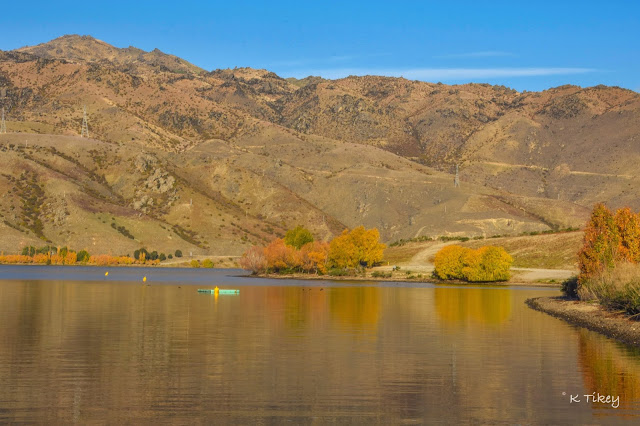One of the many rewards of this trip has been seeing how diverse the South Island's landscape is. Sometimes, the contrast has been noticeable within a short distance.
Lindis Pass is an example of this. It's barren, remote, unique and breath-taking.
Lindis Pass Scenic Reserve was formed in 1976, and was one of the first tussock reserves in New Zealand. The road through the pass is hilly and winding and is about 60kms long.
The rolling mountainside (with an altitude of 971m) is covered in tussock grass, and for many months of the year you can see snow, sometimes down to the side of the road.
Lindis Pass links the Mackenzie Basin with Central Otago and crosses a saddle between the valleys of Lindis and the Ahuriri River.
The little bus chugged up the pass without any trouble, the long stretches of road made it an easy climb. Once near the summit, I pulled over, it was time to give the dogs a break and for me to admire the view.
After the dogs had sniffed everything in sight and stretched their legs, we were back on the road. Before long, without looking at any road signs, I knew we were in Otago.
How? The countryside gave it away - the distinctive craggy schist rock formations suddenly appeared along the countryside.
I was rapt when we arrived in Cromwell. Finally, we were here, in the area, known for it's spectacular autumn scenery!
I was hoping to stay at the Rotary Glen NZMCA Park beside Lake Dunstan, I had read reviews about it being a nice spot to stay, however it has a limit of 10 campervans. Knowing there were other places I could park if there were already 10 campers, I went to check it out.
Luckily, when I arrived there were only two others there. So I drove in and parked beside some spectacular golden poplars.
And, as we always do. It was off with the key. On with the gas. And then the three of us set off to explore.
Directly across from the park, was lovely Lake Dunstan.
Lake Dunstan is a man-made lake and reservoir which was formed on the Clutha River when the Clyde Dam was developed.
The lake provides irrigation to nearby stone fruit orchards and vineyards. It's also popular for swimming, boating, waterskiing, fishing and rowing.
Clearly the smell of rabbits in the air was strong. The dogs were eager to check out every bush and cluster of plants in sight.
We followed the edge of the lake for an hour or more and then turned back.
Parts of the foreshore was lined with Briar Roses. Their thorny branches were hanging heavily with bright orangey-red rose hips.
Legend has it Chinese Goldminers back in the 1860s brought briar roses to New Zealand as a source of vitamin C. The Otago winters were (and are) harsh and as rose hips have many medicinal uses, the Chinese used them as an aid to help them survive the cold winters.
During WW11, due to the lack of citrus fruit, rose hip gathering was a popular and meaningful pastime in autumn and early winter.
Rose hips are the fruit of the briar rose and also contain the seeds. Rose hips are high in vitamin C, which assist with immunity. They also contain anti-inflammatory properties and evidence suggests these properties are effective in relieving symptoms associated with rheumatoid arthritis and osteoarthritis.
Being rich in essential fatty acids (omega 6 and omega 3), makes them beneficial to skin care, e.g, dermatitis, acne, eczema, sunburn, scar tissue and wrinkles (*sigh* - if only I'd known that earlier, I would've collected bucket loads of those rose-hips and smothered my face with them! haha). I'll chalk it up, for another reason to come back and visit!
Birds and maybe rabbits, have helped disperse the briar rose seeds. Briar roses are considered a pest to farmers, they establish resistant thickets in poor pastures and can tolerate drought, hot to cold temperatures, and can thrive in low fertile soils.
When we arrived back at the NZMCA Park, we were greeted by lots of rabbits. They barely glanced in our direction, obviously we weren't a threat.
The dogs were on their leads and they were truly mesmerised. They would've done anything to be let off!
Honestly, I don't think Oakly slept at all that night! Every time I woke, he was sitting beside me with his face glued to the window. I could see the rabbit's silhouettes as they sat on the nearby ridge. Admittedly, they were entertaining, jumping in the air, twisting and spinning around (this cute behaviour is known as a 'binky'). Others were grooming themselves, licking their paws and rubbing their faces or just sitting still.
Thankfully, Oakly spent the whole night watching. He never made a noise. So Boo and I had a great night's sleep.




















No comments:
Post a Comment
Leave a comment - I'd love to hear from you.